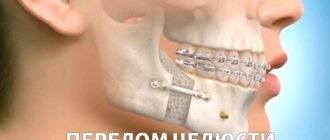A lump appears on the chin quickly. Overnight is enough for a large ball to ripen. The causes of compaction under the skin are varied. Therefore, when a lump appears, it is recommended to immediately consult a doctor, after which it can be stated that the defect is not cosmetic in nature. To identify the cause of the compaction as soon as possible and begin therapy.
A skin lump in the chin area can occur due to inflammation, infections, and oncology.
Cyst of tooth and jaw
Often, patients who go to doctors with complaints of a lump under the jaw on the right or left are diagnosed with a “cyst”. Pathology can develop due to diseased or poorly treated teeth, various jaw injuries, and ENT diseases. A cyst can go unnoticed for a long time, since it is small in size and does not cause any pain. Problems arise as it grows. A formation can be detected in the initial stages only on an x-ray during a routine examination at the dentist.
The cyst may go undetected for a long time
Read about what types of cysts there are and how to treat them in the feature article on the website.
The cyst must be removed surgically. If it is allowed to grow further, it will begin to destroy the bone tissue of the jaw, can lead to facial deformation, and be complicated by such a serious disease as osteomyelitis.
Will it be possible to save the tooth after removing the cyst? This is possible if all procedures are carried out under a microscope. A high-precision optical device will allow the doctor to see the clinical picture in detail, to precisely and precisely influence only the tumor itself, while preserving healthy tissue as much as possible. Removal of a cyst is often performed with resection (cutting off) of the root apex. And the microscope allows you to carry out the operation in the most gentle way and even fill the canals in a retrograde way, that is, through the apex of the root, if, for example, there is a crown on the tooth (without the need to remove it). But, of course, saving is possible if the situation is not too advanced.
Reasons for the formation of bumps on the gums
To find out why a lump appeared on the gum, you need to make a correct diagnosis; only a specialist can do this. There are several reasons why swelling appears, but none of them are harmless. When diagnosing, the nature of the formation, color, density, presence or absence of pain, purulent exudate is taken into account, and the nature of the disease is clarified - infectious or other.
Important! Basically, most dental problems are associated with poor oral care. As a result, mucosal pathology develops with its own symptoms.
The reasons why a lump appears between the gum and cheek may be the following:
- irregular and illiterate oral care, resulting in infection affecting periodontal tissues;
- complications of untreated caries - infectious lesions of the roots (fistula, periostitis);
- periodontitis;
- complications resulting from dental implantation;
- improper wearing or manufacturing of orthopedic structures;
- cystic formations;
- gingivitis;
- periodontal trauma (hematoma);
- benign neoplasms (epulis, fibropapilloma);
- malignant tumors.
There is another reason for the occurrence of periodontal compaction. If a child has a white bump on his gum, this may indicate the eruption of a new tooth. Short-term swelling is not terrible, but if after a long time the tooth does not appear, you should consult a surgeon.
Attention!
Many are in no hurry to go to the doctor, since the growth does not hurt. The absence of discomfort does not indicate the absence of disease. Remember: if a lump appears on your gum, only a doctor will determine what to do and how serious the consequences will be!
Periostitis of the jaw
Periostitis, or gumboil, occurs when a person is in no hurry to treat teeth affected by caries, pulpitis or periodontitis. The disease can also appear after tooth extraction if an infection gets inside the wound. Less commonly, pathology occurs as a complication of tonsillitis, influenza or ARVI, due to jaw injuries.
The photo shows periostitis on an x-ray
Periostitis is a purulent-inflammatory disease that affects the periosteum. If left untreated, an abscess forms, inside which pus accumulates. The tumor gradually grows, involving the soft tissues of the oral cavity and face, the parotid zone, as well as the lymph nodes, which may cause the patient to feel as if there is a lump under the jaw.
Phlegmon
This is a serious complication of dental diseases such as pulpitis, periodontitis, cyst, gumboil, osteomyelitis. Occurs against a background of very weakened immunity. There are different types of this pathology depending on the location of the inflammatory process. A lump under the jaw or next to the ear may occur if there is phlegmon in the chewing space, floor of the mouth, parotid or peripharyngeal region.
The photo shows phlegmon
In addition to finding a lump under your jaw or near your ear, you will experience pain when swallowing and difficulty opening your mouth wide and moving your lower jaw. This disease is difficult and takes a long time to treat, often in a hospital setting, but if it is not treated, dangerous complications can arise: serious facial deformities, sepsis, disability and even death.
Submandibular lymphadenitis
A lump under the jaw on the left or right may indicate inflammation of the lymph nodes. With a disease such as submandibular lymphadenitis, the lump can also be located under the ear on the jaw. Moreover, you may find not one, but several balls (bumps) under the skin that feel hard and painful to the touch. Other symptoms also indicate the disease: increased body temperature, general weakness, pain during swallowing movements.
The disease requires timely diagnosis and treatment. Otherwise, it becomes chronic, and pus may accumulate in the lymph nodes. This is very dangerous, since under such circumstances the infection can quickly spread throughout the body and provoke the development of sepsis.
Causes
The causes of lumps in the jaw area are different. But if they appear outside, on the right or left side (closer to the ear) and under the chin, most often this indicates inflammation of the lymph nodes.
The formation of a lump on the jaw is accompanied by discomfort, pain, fever, and insomnia.
The diagnosis is made based on the results of an examination, blood test, x-ray, ultrasound, biopsy, computed tomography or magnetic resonance imaging.
Treatment depends on the underlying cause that caused the lump to appear.
When pathogenic bacteria enter the body, the immune system activates the production of lymph. The external manifestation of this process is an increase in the size of the submandibular lymph nodes.
One of the reasons for the development of lymphadenitis is diseases of the oral cavity:
- Pulpitis is inflammation of the dental pulp caused by streptococcal or staphylococcal infection.
- Alveolitis is an acute inflammation of the walls of the socket at the site of tooth extraction.
- Periodontitis is an inflammation of the tissues surrounding the root of the tooth. Its main symptoms are: pain in the area of the affected tooth, swelling of the gums and swelling of the cheek. Can lead to the formation of jaw cysts and osteomyelitis.
- Stomatitis is an inflammation of the oral mucosa.
- An abscess is an inflammation of the root of a tooth, accompanied by an accumulation of pus.
When signs of lymphadenitis appear, dental pathologies are first excluded. Enlarged lymph nodes are a secondary symptom: it occurs when a visit to the dentist is delayed or after the removal of a tooth affected by a purulent infection. The primary signs of dental disease are gum inflammation and pain.
In 15% of cases, the reasons for the formation of seals in the maxillofacial area are dental. In addition to lymphadenitis, processes occurring in the oral cavity lead to the appearance of bumps on the gums.
They may be a sign of the growth of a permanent (in young children - baby) tooth or pathology of an existing dentition. The following appear as bumps on the gums near the teeth:
- Exostosis is a jaw abnormality characterized by the appearance of bony protrusions on the gums.
- Epulis is a pink or red mushroom-shaped tumor. Appears when the gums are mechanically damaged by a filling or tartar. Other causes of its occurrence: bruises and burns, congenital malocclusion, the use of low-quality dentures, hormone imbalance.
- A fistula is a small seal on the gum with a hole. When an infection occurs, pus flows out of it. The main reason for the formation of fistulas is the granulating form of periodontitis.
Benign tumors of bone and soft tissues of the oral cavity have a similar manifestation. The most common are:
- Ameloblastoma - mainly affects the lower jaw. It develops intraosseously and sometimes grows into soft tissues. Diagnosed at the age of 20-40 years. At first, the course of the formation is asymptomatic, but over time it increases. This leads to jaw deformation, swelling, bumps on the face on the affected side, and displacement of teeth.
- Osteoma is a tumor growing from bone tissue. It can form both on the outside of the jaw and on the inside (most often in the area of the upper dentition). With the active growth of the seal, pain appears, jaw mobility is impaired, and facial asymmetry occurs.
- Fibroma is a pathological formation that develops from the connective tissue of the tooth germ. Clinical signs of the tumor are mild: sometimes there is aching pain and inflammation at the site of its location.
- Cementoma is localized, as a rule, on the lower jaw: in the area of the tooth root. When it reaches large sizes, it causes facial deformation.
Malignant tumors of the oral cavity (carcinoma, sarcoma) are rarely diagnosed. But if a lump appears on your gums, you should definitely see a doctor: a dentist and, if necessary, an oncologist.
Non-dental reasons for formation
If the patient does not have pathologies of the teeth, soft and bone tissues of the oral cavity, one should look for another reason for the formation of lumps on the jaw. Inflammation and an increase in the size of the submandibular lymph nodes provoke diseases.
Inflammation of the lymph nodes (regional lymphadenitis) looks like a lump and can be located in the area under the lower jaw.
It often occurs against the background of tuberculosis. Therefore, when such a lump appears, it is worth taking an x-ray of the lungs or fluorography.
Dentist
Novikova Olga Alexandrovna
8 years of experience
Infectious:
- angina;
- pneumonia;
- laryngitis;
- sinusitis.
Autoimmune:
- systemic lupus;
- rheumatoid arthritis;
- leukemia.
Viral:
- chicken pox;
- whooping cough;
- measles;
- mumps.
Traumatic injuries to the lower jaw, head and hearing organs are no less rare causes of inflammation of the lymph nodes and the formation of lumps near the ear, in the chin area. At the site of the bruise, inflammation, swelling or compaction with a dense structure appears.
Why can our articles be trusted?
We make health information clear, accessible and relevant.
- All articles are checked by practicing doctors.
- We take scientific literature and the latest research as a basis.
- We publish detailed articles that answer all questions.
In the jaw area there are not only lymph nodes, but also blood vessels, salivary and sebaceous glands, bone and soft tissues. Therefore, when lumps appear on the outside of the jaw, the presence of cancer should not be ruled out. Sometimes growths under the skin of the face are benign or malignant neoplasms.
| Pathology manifested as a lump on the jaw, behind the ear, or fidgeting with it | Characteristic |
| Wen | A mobile formation with clear boundaries and a soft structure. It does not pose a health threat: in most cases it is a cosmetic problem. In the absence of infection, the lipoma does not hurt. Discomfort, pain and burning at its location indicate the presence of inflammatory processes. It occurs due to lipid metabolism disorders, clogging of the sebaceous gland, accumulation of toxins in the body |
| Fibroma | A compaction growing from connective and or fibrous tissue. It is soft to the touch, sometimes hard. Typically, tumors of this type rise above the surface of the skin. Looks like a pea, does not cause pain |
| Furuncle | Purulent inflammation on the skin that occurs when an infection enters the hair follicle of the infection. There is swelling and redness of the skin at the affected area. A mature boil looks like a conical seal |
| Hemangioma | Formations characterized by rapid growth. Occurs when blood vessels become blocked |
There are many reasons for the formation of lumps on the jaw. It is difficult to independently understand why the lumps appeared: you need to consult a doctor.
Sialadenitis
Salivary stone disease, or sialadenitis, appears due to blockage and inflammation of the salivary glands. The disease most often occurs in the submandibular and parotid areas1. Pathology develops mainly on one side of the jaw. Patients who consult a doctor with this problem complain of swelling under the jaw, chin, or near the ears. In the initial stages, the cheek and neck swell; in later stages, pain occurs when opening the mouth, talking, chewing and swallowing food.
The cause of the lump may be salivary stone disease
Sialadenitis can worsen and recur from 2 to 6 times a year. Dysfunction of the salivary glands and hyposalivation (lack of saliva) contribute to various infectious processes in the oral cavity. The most common is generalized periodontitis, due to which you can lose all your teeth.
“The other day, quite unexpectedly, a lumpy lump appeared under my chin, I went for an ultrasound, and there I was stunned by the news that these were stones in the salivary ducts. There were no other symptoms before. As treatment, they prescribed all sorts of pills and physical procedures, massage, but if it didn’t help, they said that they would put them in surgery and cut them up...”
Flo, review from 32top.ru
How to avoid a lump on your neck
It is not always possible to prevent the formation of a seal. The fact is that fibromas and lipomas have a genetic predisposition, while chemodectomas and cysts appear when leading an incorrect lifestyle. As for other types of formations, their appearance is avoided by adhering to the recommendations:
- treat skin diseases in a timely manner;
- It is advisable to be examined after injuries;
- lead a healthy lifestyle, since smoking, alcohol abuse and other bad habits significantly increase the risk of developing cancer;
- at the slightest suspicion and symptoms, consult a doctor to prevent the development of serious complications.
Benign tumor, or lipoma
A lump has appeared under your jaw on the right or maybe on the left, and you are wondering what it is? One of the most common reasons for its appearance is a large wen. To the touch, the formation is soft, motionless and painless. A small lipoma does not pose a serious threat to the body, but if it is not removed, it will continue to grow. The tumor, reaching 5–10 cm in diameter, compresses the nerve endings, disrupts blood circulation and normal cell nutrition. In addition, a large wen is an aesthetic problem, as it spoils the appearance of the face.
A small lipoma does not pose a serious threat
Under unfavorable factors (internal diseases of the body), a lipoma can degenerate into a malignant tumor.
Treatment
Most lumps are removed through surgery. However, there are formations that are treatable.
For example, boils are treated with antimicrobial and disinfectant drugs.
If the doctor expresses concerns about the identified lump, then it is worth starting treatment as quickly as possible.
After all, benign tumors eventually develop into malignant tumors, the treatment of which takes much more effort, time and money.
Atheroma of the sebaceous gland
A tumor resulting from blockage of the sebaceous glands is called atheroma or sebaceous cyst. Most often it occurs where there are a lot of sebaceous glands - on the head or face (mainly below the level of the mouth, under the jaw). Soft to the touch, mobile, painless. The lump under the jaw on the right or left increases in size very slowly and usually does not exceed 40 mm in diameter.
Atheroma most often occurs where there are many sebaceous glands
The bad thing is that atheromas often fester. They can communicate with the surface of the skin - in this case, a cheesy mass can seep out through the hole, which smells unpleasant. To avoid such unpleasant consequences, atheroma, like all neoplasms, is removed surgically.
Treatment options
In oncology, the tumor is removed, and neighboring tissues are irradiated.
Therapy consists of eliminating the cause that caused the discomfort. For this, different groups of medications, physiotherapy, and surgery are used.
- For dental diseases. Restore damaged areas, disinfect holes after removal. For long-term acute stomatitis, lidocaine-based rinses, antibiotics, and aloe juice are used. Anti-inflammatory pastes are also used for pulpitis and periodontitis. For severe pain, analgesics are prescribed.
- For autoimmune disorders. Pain is relieved with NSAIDs or glucocorticosteroids. Chondroprotectors are also used for diseases such as rheumatoid arthritis. For other disorders, vitamin supplements and cytostatics are used.
- For complicated lymphadenitis. They are treated with antibiotics, and in case of purulent processes, tumors are removed surgically.
- For oncological pathologies. Complex therapy is required, including anti-cancer treatments: radiation and chemotherapy, surgery, and a restorative complex of vitamins.
Dermatological disorders are often treated with external remedies, including antibiotics.
The use of folk remedies is appropriate at the rehabilitation stage or as part of additional treatment methods. You need to select recipes together with your doctor to avoid allergies.
Mumps or mumps
With this pathology, the salivary glands located next to the ears become inflamed. If there is a lump, swelling on the jaw or a tumor under the ear, then you can suspect that it is mumps. Additional symptoms: increased body temperature, weakness, pain in the area where tumors are located and when swallowing. Mumps most often affects children and young people.
The tumor may be caused by mumps
This disease is viral and poses a danger of infection to others, so the patient must be isolated from others. It is also important to start treatment for pathology on time because in the absence of adequate measures complications may arise, the most serious of which is infertility.
Diagnostic methods
As always, an appointment with an otolaryngologist begins with a visual examination. The doctor carefully palpates the formation on the neck and collects a detailed history based on complaints from the parents. To determine the nature of the lesion, blood flow and the exact size of the compaction, a number of instrumental and laboratory studies are carried out, including:
- Ultrasound, MRI and X-ray provide detail of soft tissues;
- biopsy followed by histological examination of the contents;
- laboratory blood tests.
As we mentioned earlier, consultation and additional examination may be required from specialists in other fields, for example in dentistry, endocrinology, oncology, dermatology. Based on the results of the examination, adequate treatment or dynamic observation will be prescribed.
Internal subcutaneous pimple or boil
If there is a small lump under the jaw on the left or right, then this may well be an ordinary subcutaneous pimple. Many people do not think that such a tumor poses a serious threat, but if you start squeezing the pimple, the infection can go inside the body, and you will end up on the surgical table. Moreover, if such pimples appear frequently and do not go away for a long time, then this signals problems with the internal organs, excretory, reproductive and endocrine systems.
The photo shows a boil under the jaw
Do not under any circumstances try to crush, puncture or heat the lumps under the jaw. You can bring an infection inside, cause complications and the appearance of rashes in new places.
Lymphoma (malignant neoplasm)
As we noted above, a lump under the jaw on the right or left may indicate inflammation of the lymph nodes. The tumor is often benign, but in some situations it is malignant.
The pathology occurs against the background of low immunity, hereditary predisposition, prolonged exposure to negative factors (for example, carcinogenic substances), after operations. It is characterized not only by swelling in the area of the lymph nodes, but also by headaches, shortness of breath, cough, sweating, and fatigue.
In any case, you should not delay your visit to the doctor and be sure to get a diagnosis.
Notice
: Undefined variable: post_id in
/home/c/ch75405/public_html/wp-content/themes/UltraSmile/single-item.php
on line
45 Notice
: Undefined variable: full in
/home/c/ch75405/public_html/wp-content /themes/UltraSmile/single-item.php
on line
46
Rate this article:
( 5 ratings, average: 4.40 out of 5)
prevention
- Brezgina A.A. Clinic, diagnosis and treatment of chronic recurrent sialadenitis / Problems of dentistry. – 2006.
Expert “A lump under the jaw may be a pimple or a wen, or it may be a sign of serious dental or other diseases. If the tumor is painful, large or rapidly growing in size, the skin around it has changed color, or pus has accumulated inside - be sure to visit a dentist, ENT doctor or therapist. The sooner the problem is diagnosed, the easier and faster the treatment will be.” Dentist-therapist Elena Vladimirovna Orlova
Consulting specialist
Dzagurova Elina Ruslanovna
Doctor rating: 9.5 out of 10 (2) Specialization: Dentist-therapist Experience: 10 years
Comments
I suffered from a severe sore throat, after which two lumps appeared under the jaw on the right, the doctor said that these were lymph nodes and prescribed ointments, but nothing helped. I don’t know what to do anymore.
Mikheeva (05/01/2020 at 18:44) Reply to comment
- Enlarged lymph nodes indicate the presence of an infectious-inflammatory process in the acute or chronic stage. It is necessary to conduct a detailed diagnosis of your condition, for this you need to take smears for flora, take a detailed blood test, visit an ENT doctor and a dentist.
Editorial staff of the portal UltraSmile.ru (05/14/2020 at 09:14) Reply to comment
I have a lump on the left side opposite the corner of my mouth. It doesn’t hurt, nothing hurts, when I press on it, it’s hard. It’s been 2 weeks now and it hasn’t grown or fallen, I feel like always, I don’t have a fever, but I have lower dentures. .What is this?
Tatyana (07/04/2020 at 06:35) Reply to comment
A lump appeared 3 years ago under the jaw in the area of the lymph node and it seems that it is a single whole because... the node lost its mobility when palpated, they took a picture, a lump (1-2 cm) is visible in the picture, they said the problem was teeth, removed the problematic one, the lump remained, but did not progress, did not hurt, but when moving the neck there was an unpleasant sensation sometimes behind the ear too, an oncologist at the local he told the clinic that he wasn’t seeing anything, maybe he’d contact the oncology center, but they didn’t prescribe treatment
Alexey (09.24.2020 at 15:51) Reply to comment
He bit the same spot on his lip twice. It became swollen and there was pain on the lower side of the jaw (the lip hardly hurts), pain when moving the jaw, but not when swallowing. A small lump is felt on the bottom of the bone, which is very painful when touched.
Georgy (07.10.2020 at 19:42) Reply to comment










